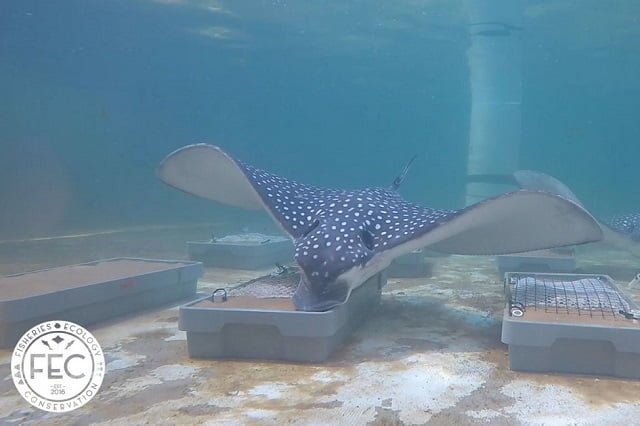
The Atlantic salmon aquaculture is an important food source, but feed costs and environmental impact are causes for concern. Selective fish breeding has the potential to improve feed conversion to growth more efficiently. However, measuring individual feed intake in a large number of fish has been a challenge.
A new study presents a promising technique using X-rays to assess food intake in Atlantic salmon. Researchers from NOFIMA, the Norwegian University of Life Sciences, and Mowi Genetics AS recorded food consumption in 700 pairs of Atlantic salmon from 34 full-sibling families using the X-ray method.
They fed fish containing small radiopaque beads and then used X-rays to measure the amount of beads ingested. This method was compared to the traditional approach of measuring food intake for entire fish tanks.
What is feed efficiency?
Feeding is a double-edged sword for salmon producers. It’s a significant expense, yet crucial for healthy growth.
Feed efficiency is a measure of how well fish convert their food into growth. Salmon that are more efficient in terms of feeding require less food to reach commercial size, resulting in:
- Lower production costs for fish farmers.
- Reduced environmental impact as fewer unconsumed feeds pollute the water.
The challenge: measuring food intake
Traditionally, researchers have relied on tank feeding, where food intake is estimated by the difference between what is offered and what is not consumed. While accurate, this method proves impractical for large-scale commercial environments where fish are housed in groups. Additionally, isolating individual fish for precise measurements often leads to reduced feeding, skewing results.
But why is measuring food intake so crucial? Because efficient fish are those that get the most out of their food.
Stay Always Informed
Join our communities to instantly receive the most important news, reports, and analysis from the aquaculture industry.
By understanding individual feeding habits, researchers can breed salmon, through genetic selection, that are better at converting food into growth and ultimately reduce costs and environmental impact.
How does the X-ray technique work?
The new X-ray method offers a revolutionary approach. Recent research utilizing the X-ray method on hundreds of salmon from multiple families yielded interesting results. The method proved reliable, with a clear genetic link to feed efficiency.
Scientists fed salmon a special feed mixed with small radiopaque beads. These beads acted as internal markers and showed up clearly in X-ray images. By taking X-rays after a single feeding, researchers could accurately assess individual food intake, a significant advancement over traditional methods.
Researchers developed the following strategies:
- Special feed: Salmon receives a special diet containing small radiopaque beads. These beads are clearly visible in X-rays.
- X-ray imaging: After a full meal, X-rays of the fish are taken. The amount of beads in their intestines indicates how much food they have consumed.
- Genetic analysis: This method allows researchers to study the genetic factors influencing feed efficiency. Scientists have known for some time that salmon have a genetic predisposition to feed efficiency. However, directly measuring individual food intake in a large number of fish has been a significant obstacle.
Results: potential of X-rays
The study found that the X-ray technique:
- Provides a reliable measure of daily food intake in Atlantic salmon (juvenile salmon).
- Shows a strong genetic link between feed efficiency and growth. According to the study, “the heritability estimate for daily food intake in Atlantic salmon using the X-ray method was significantly different from zero (0.19 ± 0.06) and was genetically correlated with growth-related traits (rg = 0.48–0.81).”
- It is highly correlated with traditional tank feeding methods. Researchers report that “daily food intake at the family level using the X-ray method was highly genetically correlated with daily food intake traits using the tank feeding method between 0.78 and 0.82, depending on whether the comparison was made at a common time, common weight, or accumulated food intake over the entire period.”
Conclusions
The X-ray method offers a powerful tool for uncovering the secrets of Atlantic salmon feed efficiency. By allowing more precise measurement of individual feeding habits, this technique could pave the way for breeding programs that prioritize the production of efficient and environmentally responsible salmon. This translates to a more sustainable future for the aquaculture industry, ensuring delicious and healthy salmon for consumers while minimizing environmental impact.
The study was funded by the Research Council of Norway and by the AquaIMPACT and NewTechAqua projects, both funded by EU Horizon 2020.
Contact
A.K. Sonesson
Norwegian Institute for Food, Fisheries and Aquaculture (NOFIMA), P.O. Box 6122, NO-9291 Tromsø, Norway
Email: Anna.Sonesson@nofima.no
Reference (open access)
Difford, G., Hatlen, B., Gjerde, B., Heia, K., Baeverfjord, G., Norris, A., & Sonesson, A. (2024). Validation and genetic parameters of the X-ray method for phenotyping individual feed intake in Atlantic salmon. Aquaculture, 586, 740738. https://doi.org/10.1016/j.aquaculture.2024.740738
Editor at the digital magazine AquaHoy. He holds a degree in Aquaculture Biology from the National University of Santa (UNS) and a Master’s degree in Science and Innovation Management from the Polytechnic University of Valencia, with postgraduate diplomas in Business Innovation and Innovation Management. He possesses extensive experience in the aquaculture and fisheries sector, having led the Fisheries Innovation Unit of the National Program for Innovation in Fisheries and Aquaculture (PNIPA). He has served as a senior consultant in technology watch, an innovation project formulator and advisor, and a lecturer at UNS. He is a member of the Peruvian College of Biologists and was recognized by the World Aquaculture Society (WAS) in 2016 for his contribution to aquaculture.




